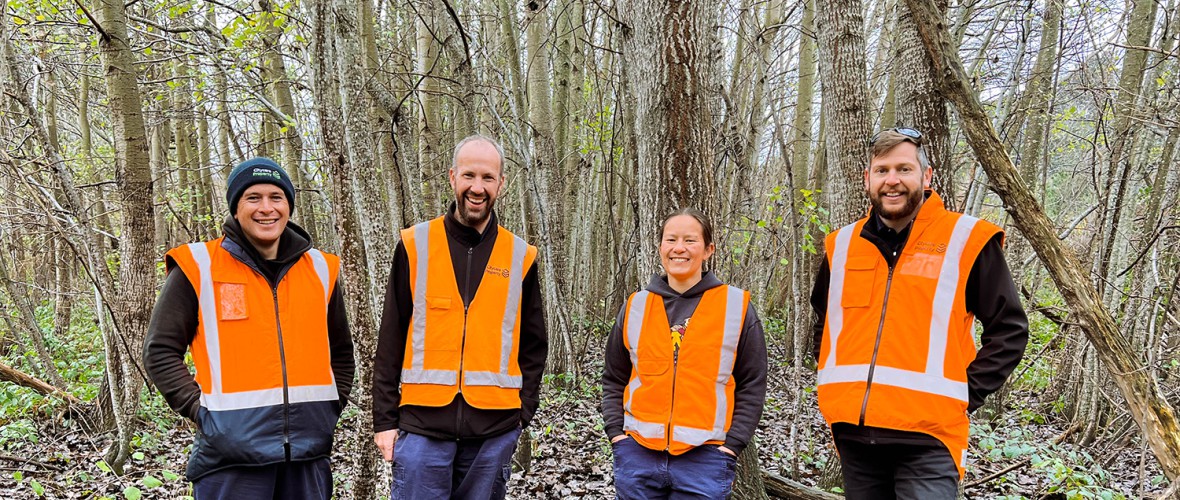Comprising 54 hectares of Waimakariri River berm, northwest of Christchurch, the Waimakariri Upstream Berm Transition Project is a three-year, native restoration and enhancement project Citycare Property is currently undertaking on behalf of Environment Canterbury (ECan)
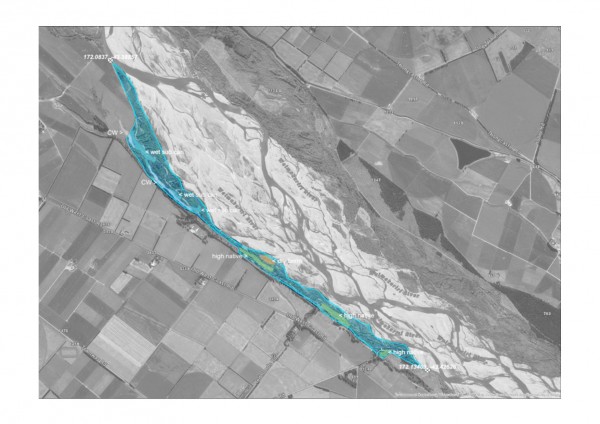
The Waimakariri Upstream Berm Transition Project is a native restoration and enhancement project covering an area of 54 hectares of the Waimakariri River berm.
Awarded to Citycare Property in May 2021, the project is designed to improve biodiversity within the catchment area through a staged programme of pest weed control, access clearing and planting of more than 12,000 native plants — with the objective of retaining, supplementing and increasing the existing native plant population.
As the project nears the half-way point, we caught up with members of the Citycare Property Open Spaces Management (OSM) team who have been tasked with carrying out this important and often exhausting work, much of which to date has involved cutting paths through the almost impenetrable scrub, clearing vast tracts of old man’s beard (Clematis vitalba) – an invasive vine species that climbs high into tree canopies, eventually smothering even very mature trees – and identifying female specimens of grey willow for future treatment.
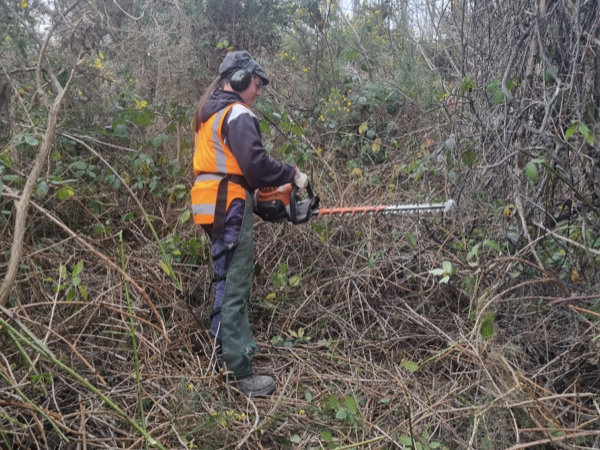
Citycare Property OSM team member Layling Stanbury gets to work clearing walking tracks through the scrub.
Citycare Property: Helping restore our native flora
During the first 12 months, the team — comprising Steve Frame, Kyle Griffiths, Nasir Mulligan, Layling Stanbury, Liam Foote and Yosep Irfande — made a number of unexpected observations regarding native flora as they have cleared access paths and carried out pest weed control.
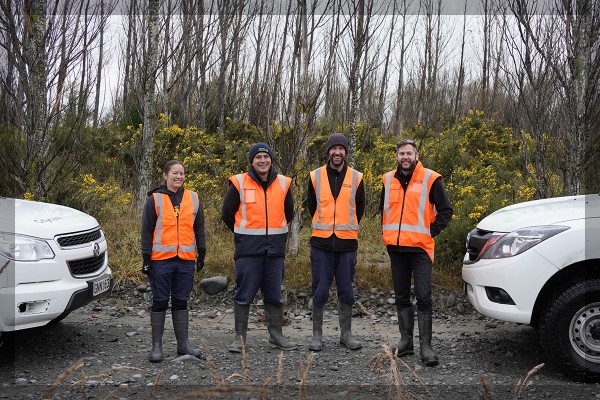
Members of the Waimakariri Upstream Berm Transition Project team (from left) Layling Stanbury, Nasir Mulligan, Kyle Griffiths and Steve Frame.
These observations include examples of natives having adpated to environments not typical to their usual habitats, says Kyle Griffiths.
“There have been a number of discoveries of native plants growing in conditions that we traditionally wouldn't consider very likely for survival, including toe toe (Austroderia richardii) and kanuka (Kunzea serotina) in the depths of the wetland zone. Both these and other similar discoveries make for an interesting discussion of how this comes to happen and also leads us to question how the landscape has shifted over time from the impact of agriculture and the introduction of exotic species. The story of these remnant species can also provide us with an insight of how this place looked in the past.”
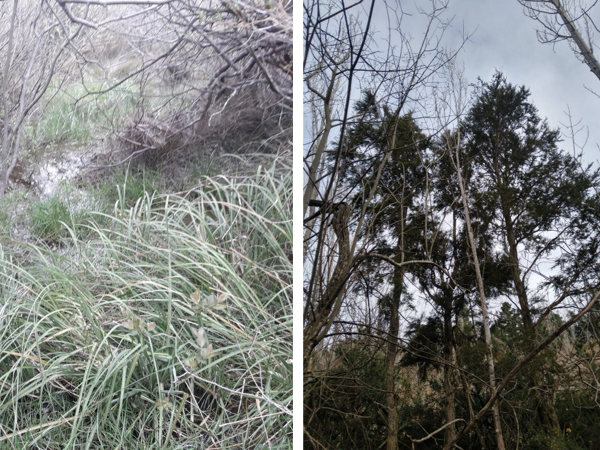
The Citycare Property OSM team has made a number of interesting discoveries, including instances of toe toe (left) and mature kanuka growing in the depths of the wetland zone — not the usual habitat for either species.
There have also been instances of plants in symbiotic relationships such as an area of pohueue (Muehlenbekia australis), tataramoa or bush lawyer (Rubus squarrosa), and kaihua or New Zealand jasmine (Parsonsia capsularis) growing together without putting stress on each other. They’ve succeeded by using each other to hold on to the bank, developing new anchoring points and base points to grow new shoots, providing bank stabilisation.
In another example, kanuka was found to be coexisting with gorse (Ilex europea). “Gorse is classed as an invasive weed but it can also act as a nursery plant, in this instance supporting a native species by fixating the soil with nitrogen, which in turn promotes growth, while the height of the gorse has created a shelter belt from wind, frost and prolonged sun exposure,” says Kyle.
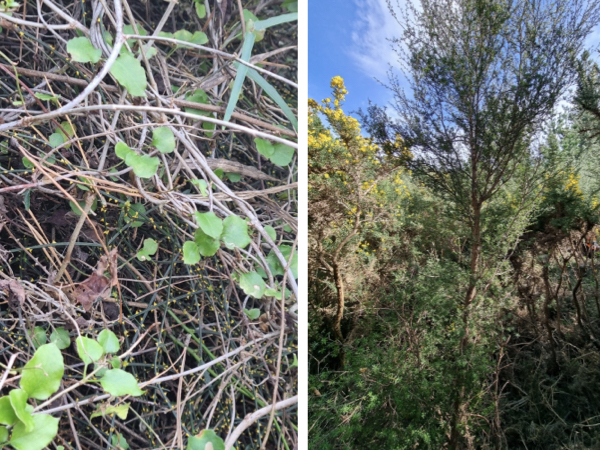
Other finds include instances where two or more plants are exisiting in a symbiotic relationship — such as pohueue, tataramoa and kaihua (left) and kanuka and gorse (right).
In some areas where kanuka and gorse coexist in dense pockets, the team has crown-lifted the lower branches of gorse to further assist the kanuka — or in some instances, manuka — with self-seeding.
Waimakariri: Our very own Garden of Eden
Other native plants found throughout the area include karamu (Coprosma robusta) in full fruit and swarming with tauhou (wax-eye), porcupine shrub (Melicytus alpinus), hound’s tongue (Microsorum pustulatum), dwarf kowhai (Sophora prostata), mikimiki (Coprosma crassifolia) and maidenhair vine (Muehlenbekia complexa) growing in odd individual stands. Kyle reports that the dwarf kowhai had numerous seedlings around the parent plant and had last season’s seeds present, which were viable.
The team also discovered another native planting consisting of hebe, pseudopanax, corprosma and houheria that appears to have been there for some time with the plants having established themselves quite well — some showing leggy forms, which is a result of competing with blackberry for light. Several totara and kahikatea were also found and which are healthy and growing well.
Particularly pleasing has been the recent discovery of two of our native ground covers — golden scabweed (Raoulia australis) and tutahuna (Raoulia tenuicaulis). Such discoveries are recorded via the iNaturalist app and added to the New Zealand database of Flora and Fauna, which records numbers of each individual specie found. This is especially important in the case of golden scabweed as the plant has recently be reclassified as “at risk – declining”.
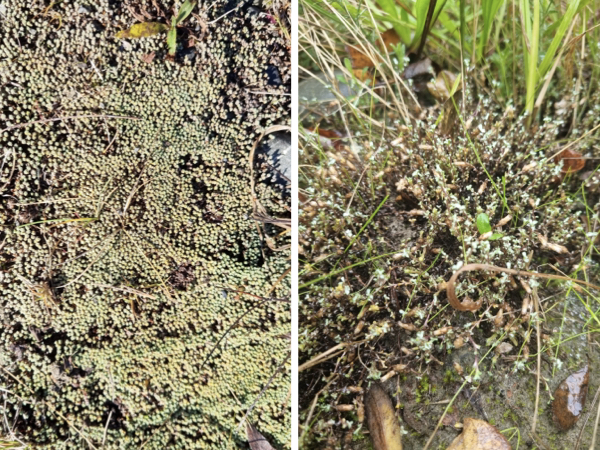
Significant flora discoveries include golden scabweed (left), which has recently be classified as “at risk – declining” and tutahuna, both native ground cover plants.
Sightings have not just been limited to plant species either. The team has been in the presence of a pair of tomtits in the area as they come and go throughout the day and have made numerous sightings of multiple bellbirds in the area at various times and locations. One of the team members also came across an example of the New Zealand Bristly Stick Insect (Argosarchus horridus).
All these discoveries help emphasise the importance of the work being carried out by ECan and Citycare Property in restoring native habitats.
